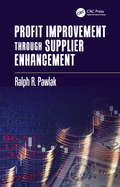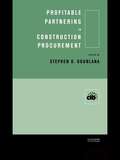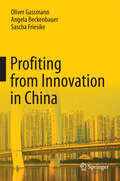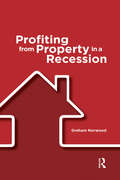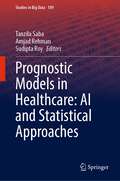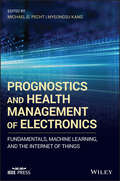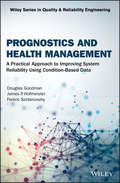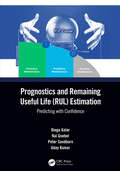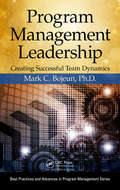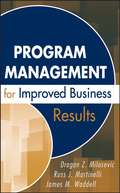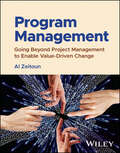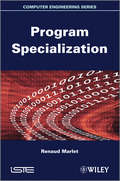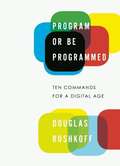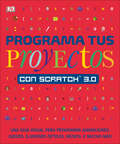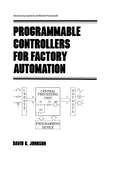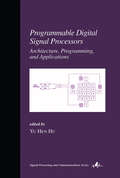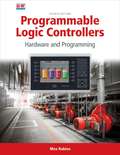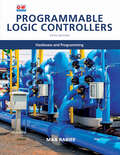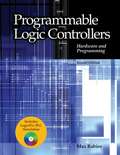- Table View
- List View
Profit Improvement through Supplier Enhancement (Systems Innovation Book Series)
by Ralph R. PawlakThis book deals with the improvement of suppliers in order to increase a company's top and bottom-line. The enhancement of suppliers can be accomplished in a series of steps when conditions warrant intervention. They can also be generated through direct quality mentoring when the supplier does not have the basic skills or abilities to adequately address impending problems. Also included are guideline activities which will aid in achieving and attaining improved profitability and competitiveness in the world market. Packed with examples, problems, and forms to allow easy establishment of systems, makes the information presented more easily understood, interesting, and useful.
Profit Maximization Techniques for Operating Chemical Plants
by Sandip K. LahiriA systematic approach to profit optimization utilizing strategic solutions and methodologies for the chemical process industry In the ongoing battle to reduce the cost of production and increase profit margin within the chemical process industry, leaders are searching for new ways to deploy profit optimization strategies. Profit Maximization Techniques For Operating Chemical Plants defines strategic planning and implementation techniques for managers, senior executives, and technical service consultants to help increase profit margins. The book provides in-depth insight and practical tools to help readers find new and unique opportunities to implement profit optimization strategies. From identifying where the large profit improvement projects are to increasing plant capacity and pushing plant operations towards multiple constraints while maintaining continuous improvements—there is a plethora of information to help keep plant operations on budget. The book also includes information on: ● Take away methods and techniques for identifying and exploiting potential areas to improve profit within the plant ● Focus on latest Artificial Intelligence based modeling, knowledge discovery and optimization strategies to maximize profit in running plant. ● Describes procedure to develop advance process monitoring and fault diagnosis in running plant ● Thoughts on engineering design , best practices and monitoring to sustain profit improvements ● Step-by-step guides to identifying, building, and deploying improvement applications For leaders and technologists in the industry who want to maximize profit margins, this text provides basic concepts, guidelines, and step-by-step guides specifically for the chemical plant sector.
Profitable Partnering in Construction Procurement
by Stephen O. OgunlanaProfitable Partnering in Construction Procurement is a compilation of papers presented at the CIB W92 Symposium held in Chaing Mai, Thailand in January 1999. This volume, drawing on contributions from leading experts in construction contract procurement from 22 countries, addresses the issues of culture within organisations and national cultures and their impact on procurement, performance and profitability.Substantial coverage is given to private finance projects, privatised infrastructure projects, contractor selection and prequalification, decision support systems for procurement, management of design, contracts and contract documents, sustainable construction and the performance of procurement systems.Profitable Partnering in Construction Procurement is a reference for construction professionals and researchers, contract administrators and lawyers wishing to gain an understanding of the complex issues of harmony and profit in construction procurement.
Profiting from Innovation in China
by Oliver Gassmann Sascha Friesike Angela BeckenbauerChina is dramatically catching up and is rapidly becoming a leading technological innovator on the global scale. The number of Chinese firms with global ambitions is growing fast, more and more technological innovation is coming from China, and the number of patents in China is also growing steadily. The negative side of this development is the still insufficient protection of intellectual property in China. The phenomenon of counterfeits originating from China has increased constantly over the past two decades. Moreover, within the past ten years the scale of intellectual property theft has risen exponentially in terms of its sophistication, volume, the range of goods, and the countries affected. This book addresses managers dealing with innovation in China, and offers concrete advice on how Western firms can benefit from these innovations. Among others, it provides examples and checklists to help decision-makers active in China.
Profiting from Property in a Recession
by Graham NorwoodWritten by an experienced property journalist with over twenty years of insider knowledge, this book provides budding property developers and investors with all they need to know to profit from property. The author offers a new twist on buy-to-let and shows how the market for renting to some groups is expanding even in these tough times. Overseas opportunities are examined too, identifying which countries offer the best opportunities to buy cheap, let and then sell. For investors willing to get their hands dirty there is also an explanation of exactly how to pursue a self-build or renovation project and sell at a profit – with advice on finding the right craftsmen, writing contracts and monitoring progress, plus selecting the best estate agent. The book also looks at how amateur investors can enter the complicated commercial sector of shops and offices, and discusses property investment trusts for those with faith in the stock market.
Prognostic Models in Healthcare: AI and Statistical Approaches (Studies in Big Data #109)
by Sudipta Roy Tanzila Saba Amjad RehmanThis book focuses on contemporary technologies and research in computational intelligence that has reached the practical level and is now accessible in preclinical and clinical settings. This book's principal objective is to thoroughly understand significant technological breakthroughs and research results in predictive modeling in healthcare imaging and data analysis. Machine learning and deep learning could be used to fully automate the diagnosis and prognosis of patients in medical fields. The healthcare industry's emphasis has evolved from a clinical-centric to a patient-centric model. However, it is still facing several technical, computational, and ethical challenges. Big data analytics in health care is becoming a revolution in technical as well as societal well-being viewpoints. Moreover, in this age of big data, there is increased access to massive amounts of regularly gathered data from the healthcare industry that has necessitated the development of predictive models and automated solutions for the early identification of critical and chronic illnesses. The book contains high-quality, original work that will assist readers in realizing novel applications and contexts for deep learning architectures and algorithms, making it an indispensable reference guide for academic researchers, professionals, industrial software engineers, and innovative model developers in healthcare industry.
Prognostics and Health Management of Electronics: Fundamentals, Machine Learning, and the Internet of Things (Wiley - IEEE)
by Michael G. Pecht Myeongsu KangAn indispensable guide for engineers and data scientists in design, testing, operation, manufacturing, and maintenance A road map to the current challenges and available opportunities for the research and development of Prognostics and Health Management (PHM), this important work covers all areas of electronics and explains how to: assess methods for damage estimation of components and systems due to field loading conditions assess the cost and benefits of prognostic implementations develop novel methods for in situ monitoring of products and systems in actual life-cycle conditions enable condition-based (predictive) maintenance increase system availability through an extension of maintenance cycles and/or timely repair actions; obtain knowledge of load history for future design, qualification, and root cause analysis reduce the occurrence of no fault found (NFF) subtract life-cycle costs of equipment from reduction in inspection costs, downtime, and inventory Prognostics and Health Management of Electronics also explains how to understand statistical techniques and machine learning methods used for diagnostics and prognostics. Using this valuable resource, electrical engineers, data scientists, and design engineers will be able to fully grasp the synergy between IoT, machine learning, and risk assessment.
Prognostics and Health Management of Engineering Systems
by Nam-Ho Kim Dawn An Joo-Ho ChoiThis book introduces the methods for predicting the future behavior of a system's health and the remaining useful life to determine an appropriate maintenance schedule. The authors introduce the history, industrial applications, algorithms, and benefits and challenges of PHM (Prognostics and Health Management) to help readers understand this highly interdisciplinary engineering approach that incorporates sensing technologies, physics of failure, machine learning, modern statistics, and reliability engineering. It is ideal for beginners because it introduces various prognostics algorithms and explains their attributes, pros and cons in terms of model definition, model parameter estimation, and ability to handle noise and bias in data, allowing readers to select the appropriate methods for their fields of application. Among the many topics discussed in-depth are: * Prognostics tutorials using least-squares * Bayesian inference and parameter estimation * Physics-based prognostics algorithms including nonlinear least squares, Bayesian method, and particle filter * Data-driven prognostics algorithms including Gaussian process regression and neural network * Comparison of different prognostics algorithms The authors also present several applications of prognostics in practical engineering systems, including wear in a revolute joint, fatigue crack growth in a panel, prognostics using accelerated life test data, fatigue damage in bearings, and more. Prognostics tutorials with a Matlab code using simple examples are provided, along with a companion website that presents Matlab programs for different algorithms as well as measurement data. Each chapter contains a comprehensive set of exercise problems, some of which require Matlab programs, making this an ideal book for graduate students in mechanical, civil, aerospace, electrical, and industrial engineering and engineering mechanics, as well as researchers and maintenance engineers in the above fields.
Prognostics and Health Management: A Practical Approach to Improving System Reliability Using Condition-Based Data (Quality and Reliability Engineering Series)
by Ferenc Szidarovszky Douglas Goodman James P. HofmeisterA comprehensive guide to the application and processing of condition-based data to produce prognostic estimates of functional health and life. Prognostics and Health Management provides an authoritative guide for an understanding of the rationale and methodologies of a practical approach for improving system reliability using conditioned-based data (CBD) to the monitoring and management of health of systems. This proven approach uses electronic signatures extracted from conditioned-based electrical signals, including those representing physical components, and employs processing methods that include data fusion and transformation, domain transformation, and normalization, canonicalization and signal-level translation to support the determination of predictive diagnostics and prognostics. Written by noted experts in the field, Prognostics and Health Management clearly describes how to extract signatures from conditioned-based data using conditioning methods such as data fusion and transformation, domain transformation, data type transformation and indirect and differential comparison. This important resource: Integrates data collecting, mathematical modelling and reliability prediction in one volume Contains numerical examples and problems with solutions that help with an understanding of the algorithmic elements and processes Presents information from a panel of experts on the topic Follows prognostics based on statistical modelling, reliability modelling and usage modelling methods Written for system engineers working in critical process industries and automotive and aerospace designers, Prognostics and Health Management offers a guide to the application of condition-based data to produce signatures for input to predictive algorithms to produce prognostic estimates of functional health and life.
Prognostics and Remaining Useful Life (RUL) Estimation: Predicting with Confidence
by Peter Sandborn Uday Kumar Diego Galar Kai GoebelMaintenance combines various methods, tools, and techniques in a bid to reduce maintenance costs while increasing the reliability, availability, and security of equipment. Condition-based maintenance (CBM) is one such method, and prognostics forms a key element of a CBM program based on mathematical models for predicting remaining useful life (RUL). Prognostics and Remaining Useful Life (RUL) Estimation: Predicting with Confidence compares the techniques and models used to estimate the RUL of different assets, including a review of the relevant literature on prognostic techniques and their use in the industrial field. This book describes different approaches and prognosis methods for different assets backed up by appropriate case studies. FEATURES Presents a compendium of RUL estimation methods and technologies used in predictive maintenance Describes different approaches and prognosis methods for different assets Includes a comprehensive compilation of methods from model-based and data-driven to hybrid Discusses the benchmarking of RUL estimation methods according to accuracy and uncertainty, depending on the target application, the type of asset, and the forecast performance expected Contains a toolset of methods and a way of deployment aimed at a versatile audience This book is aimed at professionals, senior undergraduates, and graduate students in all interdisciplinary engineering streams that focus on prognosis and maintenance.
Program Earth: Environmental Sensing Technology and the Making of a Computational Planet (Electronic Mediations #49)
by Jennifer GabrysSensors are everywhere. Small, flexible, economical, and computationally powerful, they operate ubiquitously in environments. They compile massive amounts of data, including information about air, water, and climate. Never before has such a volume of environmental data been so broadly collected or so widely available.Grappling with the consequences of wiring our world, Program Earth examines how sensor technologies are programming our environments. As Jennifer Gabrys points out, sensors do not merely record information about an environment. Rather, they generate new environments and environmental relations. At the same time, they give a voice to the entities they monitor: to animals, plants, people, and inanimate objects. This book looks at the ways in which sensors converge with environments to map ecological processes, to track the migration of animals, to check pollutants, to facilitate citizen participation, and to program infrastructure. Through discussing particular instances where sensors are deployed for environmental study and citizen engagement across three areas of environmental sensing, from wild sensing to pollution sensing and urban sensing, Program Earth asks how sensor technologies specifically contribute to new environmental conditions. What are the implications for wiring up environments? How do sensor applications not only program environments, but also program the sorts of citizens and collectives we might become?Program Earth suggests that the sensor-based monitoring of Earth offers the prospect of making new environments not simply as an extension of the human but rather as new &“technogeographies&” that connect technology, nature, and people.
Program Governance
by Muhammad Ehsan KhanAlthough program management has received much attention in recent books, program governance remains a relatively new subject. While selected books and standards touch on this important topic, few are devoted to program governance as a subject. This book fills that need.Program Governance provides a thorough understanding of governance while reviewi
Program Management Leadership: Creating Successful Team Dynamics (Best Practices in Portfolio, Program, and Project Management #9)
by Mark C. BojeunThis is not another how-to guide for program managers or another reiteration of the Project Management Institute's standards for program management. Instead, Program Management Leadership: Creating Successful Team Dynamics examines various leadership approaches and illustrates the value of effective leadership styles in Program Management for
Program Management for Improved Business Results
by Russ Martinelli James M. Waddell Dragan Z. MilosevicThe need for information on program management is more critical now than ever before. PMIs development of a new standard on program management is driving even greater interest. At the same time, there are few books covering the subject, which provide practical answers, benchmarks, and case studies, however, this book fills the gap. The authors focus on both the macro level of integrating projects and portfolios into the business strategy and the micro level of managing a single program. It contains 6 issue-oriented cases weaved throughout the text, and an additional 5 comprehensive cases in the appendix. The result is a blueprint for the successful implementation of program management.
Program Management for Improved Business Results
by James M. Waddell Russ J. Martinelli Tim J. RahschulteSuperior program management begins with superior information and strategy Program Management for Improved Business Results, Second Edition is a practical guide to real-world program management, written to align with the rigorous PMI® PgMP® certification standards. The book explains the benchmarks and best practices that help shape a superior program manager, and provides case studies that illustrate the real-world application of management concepts. Written by a team composed of both industry professionals and academics, the book strikes a balance between theory and practice that facilitates understanding and better prepares candidates for the PgMP. Managers at all levels will learn the insights and techniques that are shaping modern management expectations. The Project Management Institute and the Product Development and Management Association both agree that program management is a critical element in the successful integration of business strategy and project management. The certification process is difficult, and few complete it – but demand for competent professionals is high. Program Management for Improved Business Results addresses this disconnect, preparing readers to fill the gaps and help businesses achieve the level of program management integration required by professional organizations. Topics include: Aligning programs with business strategy Program planning, execution, and processes Management metrics and strategic and operational tools Roles, responsibilities, and core competencies The book focuses on both the macro and the micro levels, explaining the successful integration of business strategy with project portfolios as well as the managing of a single program. Case studies present both issue-oriented and comprehensive perspectives, and guidance includes real, actionable steps. For professionals seeking improved program outcomes, Program Management for Improved Business Results is a roadmap to exceptional management skills. (PMI and PgMP are registered marks of the Project Management Institute, Inc.)
Program Management: A Life Cycle Approach (Best Practices In Portfolio, Program, And Project Management Ser.)
by Pmp Ginger Levin PgMPProgram management is a rapidly emerging offshoot of project management. So much so that AT&T, IBM, and other organizations, both large and small in all sectors, have initiated a push to certify program managers. And, although universities offer courses in program management, there are few books available to guide program managers through this
Program Management: Going Beyond Project Management to Enable Value-Driven Change
by Al ZeitounProgram Management Unique and adaptable approach to program management, offering key insights needed for professionals and business leaders to drive strategic change Program Management links business purpose, strategy, program stakeholders, benefits realization, and transformative change-making to provide a uniquely integrated view and use of program management, offering practicing initiative leaders the skills and mindset shifts needed to effectively communicate and champion programs to stakeholders. The text includes key insights into strategy execution excellence and designing risk-based governance strategies that empower a learning culture within the PMO and across the business, guidance that is customizable to the nature of strategic initiatives and change efforts at the individual and organizational level, and customization that is driven by the emphasis on the potential use of programs and projects as learning labs for different levels of complexity, organizational maturity, and diverse business contexts. Written by a highly qualified author with more than 30 years of experience in the field, Program Management covers critical topics such as: Origin of programs, program management definitions and concepts, the role of program manager vs. project manager, and the importance of value focus across the program life cycle. How leaders need to be agile, navigate political waters, manage incredible complexity, and align diverse stakeholders. Envisioning a Program Roadmap that fits context and inspires commitment to continuously achieving value. The culture for change making and the attributes for a healthy “change culture” including the future Power Skills. Also addressing the value proposition of program professionals in the future. Impact of digitalization and Artificial Intelligence (AI) on the future of programs. Creating the value-driven way of working and developing the value mindset coupled with the role of benefits management in programs and projects. The PMO as the learning engine for the enterprise and the changing role of the program offices. Becoming a Change Scientist, the maturing of value and strategic metrics in programs, and how to achieve the right metrics design and mix. For program and project managers, practitioners, PMO leaders, students in project and program management courses, and those studying for project and program management certifications, Program Management is an essential mindset, skillset, and toolset for executing a strategic plan and providing synergy, consistency in managing change, and a greater focus on achieving what matters to customers and stakeholders.
Program Specialization (Wiley-iste Ser.)
by Renaud MarletThis book presents the principles and techniques of program specialization — a general method to make programs faster (and possibly smaller) when some inputs can be known in advance. As an illustration, it describes the architecture of Tempo, an offline program specializer for C that can also specialize code at runtime, and provides figures for concrete applications in various domains. Technical details address issues related to program analysis precision, value reification, incomplete program specialization, strategies to exploit specialized program, incremental specialization, and data specialization. The book, that targets both researchers and software engineers, also opens scientific and industrial perspectives.
Program or Be Programmed: Ten Commands for a Digital Age
by Douglas RushkoffThe author recognizes programming as the new literacy of the digital age and argues that the important question is, do we direct technology, or do we let ourselves be directed by it and those who have mastered it?
Programa tus proyectos con Scratch 3.0: Una guía visual para programar animaciones, juegos, ilusiones ópticas, música (DK Help Your Kids)
by Jon WoodcockLos jóvenes más apasionados por la tecnología podrán empezar a familiarizarse con Scratch 3.0 gracias a esta guía de programación para principiantes.Aunque el mundo de la codificación está lleno de conceptos complicados, estos se volverán más sencillos y divertidos de aprender a medida que los programadores del futuro construyan sus propios proyectos usando Scratch 3.0, la última versión del lenguaje de programación más popular entre principiantes. Diseña un dinosaurio virtual o tu propia tarjeta de felicitación electrónica. Inventa tu propio juego o simulación, y crea gráficos alucinantes mientras descubres todas las cosas increíbles que un programador informático puede llegar a hacer con Scratch 3.0. Programa tus proyectos muestra cada paso visualmente para dividir la complejidad de la programación y convertirla en algo manejable, fácil de comprender, para que los proyectos más impresionantes puedan llegar a hacerse realidad. Perfecto para completos principiantes, este libro dará a los lectores más jóvenes un sólido conocimiento del mundo de la programación, preparándolos para crear sus propios proyectos desde cero e incluso llevándolos a otros lenguajes de programación más complejos como Python.
Programmable Controllers for Factory Automation
by David JohnsonThis book is intended to address both the quantitative and qualitative issues of programmable controllers for factory automation. It is helpful for both the newcomer to the field and the experienced control engineer requiring a fresh perspective.
Programmable Digital Signal Processors: Architecture: Programming, and Applications (Signal Processing and Communications)
by Yu Hen Hu"Presents the latest developments in the prgramming and design of programmable digital signal processors (PDSPs) with very-long-instruction word (VLIW) architecture, algorithm formulation and implementation, and modern applications for multimedia processing, communications, and industrial control."
Programmable Logic Controllers: Hardware And Programming
by Max RabieeProgrammable Logic Controllers: Hardware and Programming provides an introduction to PLCs and their applications in process and industrial control systems. The text begins with basic hardware and programming concepts and then progresses to system-level applications. <p><p> To prepare technicians to meet the needs of industry, the author has taken a highly practical approach, covering PLC applications, maintenance, testing, and troubleshooting. Illustrations and examples help to explain abstract concepts, and review questions at the end of each chapter allow students to practice what they have learned. <p> The thoroughly updated new edition includes a new chapter on RSLogix5000 programming and expanded coverage of HMI (human machine interface) applications.
Programmable Logic Controllers: Hardware And Programming
by Max RabieeProgrammable Logic Controllers: Hardware and Programming provides a comprehensive introduction to PLCs and their applications in process and industrial control systems. Based on RSLogix 500 programming software and the Allen-Bradley SLC 500 controller, this text uses a practical applied approach to master comprehension by beginning with concepts such as basic hardware and programming before progressing to system-level applications. PLC maintenance, testing, and troubleshooting are also covered. Clear illustrations and examples are provided in the text to help explain system functions and complex concepts.
Programmable Logic Controllers: Hardware and Programming (Second Edition)
by Max RabieeThe key concepts of PLCs are discussed using a comprehensive approach to enhance learning.
